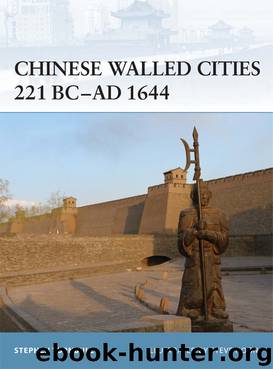Chinese Walled Cities 221 BC-AD 1644 by Stephen Turnbull

Author:Stephen Turnbull
Language: eng
Format: epub
Tags: Chinese Walled Cities 221 BC–AD 1644
ISBN: 9781782005056
Publisher: Osprey Publishing
Zhang Bi: a fortified city in miniature
Out of all the survivors of the thousands of fortified towns and cities that once dotted the Chinese countryside few are more fascinating than tiny Zhang Bi in Shanxi province, which lies 10km south-east of Jiexiu. Perfectly preserved and recently restored, Zhang Bi is like a fortified city in miniature where small details of fortifications, often absent from larger examples, may be readily studied. Yet the size of Zhang Bi makes it something of a mystery. Is it a fortified village, or an actual fortress that challenges the conventional notion that there is no such thing as a Chinese castle? The closest European analogy would be with the hilltop villages of Provence in France, or a crusader castle site where houses were built within the walls.
Zhang Bi is believed to have been built originally by Liu Wuzhou around the time of the founding of the Tang dynasty. Liu Wuzhou was one of the rebel leaders associated with the fall of the Sui dynasty. In AD 617 he murdered the governor of Mayi Commandery to the south-west of Datong, opened the granaries, brought the surrounding area under his own control and took an imperial title. He was eventually defeated by Li Shimin, the future Tang Emperor Taizong, and Zhang Bi remains his only memorial. In fact the inhabitants of Zhang Bi constructed the Kehan Memorial Temple for him, which still stands within the village and houses statues of Liu Wuzhou and his two loyal followers.
There is no rectangular layout to Zhang Bi. Instead the village is a long S-shape that has been likened to that of a dragon, a design that derives simply from Zhang Bi’s extraordinary position on a dry, rocky bluff 1,000m above sea level along precipitous cliffs. Before describing the village itself, we may note that the cliffs are pierced by a long, winding tunnel. It is entered from the village and emerges in the cliff face overlooking a steep-sided gorge. The whole tunnel is 5km long and winds in an S-shape over three layers. The upper tunnel lies between one and two metres from the surface; the middle tunnel is 8–10m down, while the lowest level descends to 17 or 20m. Only one person can pass at a time. It possesses caves for stationing as many as 20 troops as well as underground stables. There are vantage points and drainage systems. To aid ventilation the tunnel is connected to ten wells sunk from the village, and at the lowest level are underground grain storage facilities.
Download
This site does not store any files on its server. We only index and link to content provided by other sites. Please contact the content providers to delete copyright contents if any and email us, we'll remove relevant links or contents immediately.
| Africa | Americas |
| Arctic & Antarctica | Asia |
| Australia & Oceania | Europe |
| Middle East | Russia |
| United States | World |
| Ancient Civilizations | Military |
| Historical Study & Educational Resources |
The Daily Stoic by Holiday Ryan & Hanselman Stephen(3264)
The Fate of Rome: Climate, Disease, and the End of an Empire (The Princeton History of the Ancient World) by Kyle Harper(3030)
People of the Earth: An Introduction to World Prehistory by Dr. Brian Fagan & Nadia Durrani(2711)
Ancient Worlds by Michael Scott(2648)
Babylon's Ark by Lawrence Anthony(2648)
The Daily Stoic by Ryan Holiday & Stephen Hanselman(2523)
Foreign Devils on the Silk Road: The Search for the Lost Treasures of Central Asia by Peter Hopkirk(2442)
India's Ancient Past by R.S. Sharma(2432)
MOSES THE EGYPTIAN by Jan Assmann(2393)
The Complete Dead Sea Scrolls in English (7th Edition) (Penguin Classics) by Geza Vermes(2258)
Lost Technologies of Ancient Egypt by Christopher Dunn(2207)
The Earth Chronicles Handbook by Zecharia Sitchin(2203)
24 Hours in Ancient Rome by Philip Matyszak(2065)
Alexander the Great by Philip Freeman(2044)
Aztec by Gary Jennings(1992)
The Nine Waves of Creation by Carl Johan Calleman(1898)
Curse Tablets and Binding Spells from the Ancient World by Gager John G.;(1851)
Before Atlantis by Frank Joseph(1832)
Earthmare: The Lost Book of Wars by Cergat(1806)
